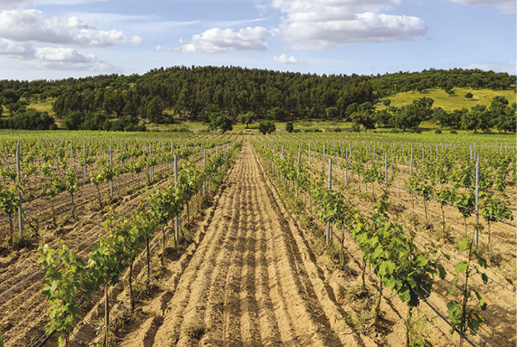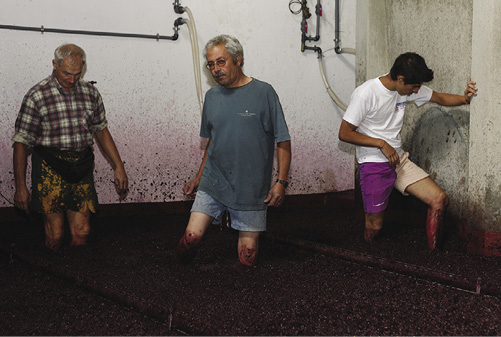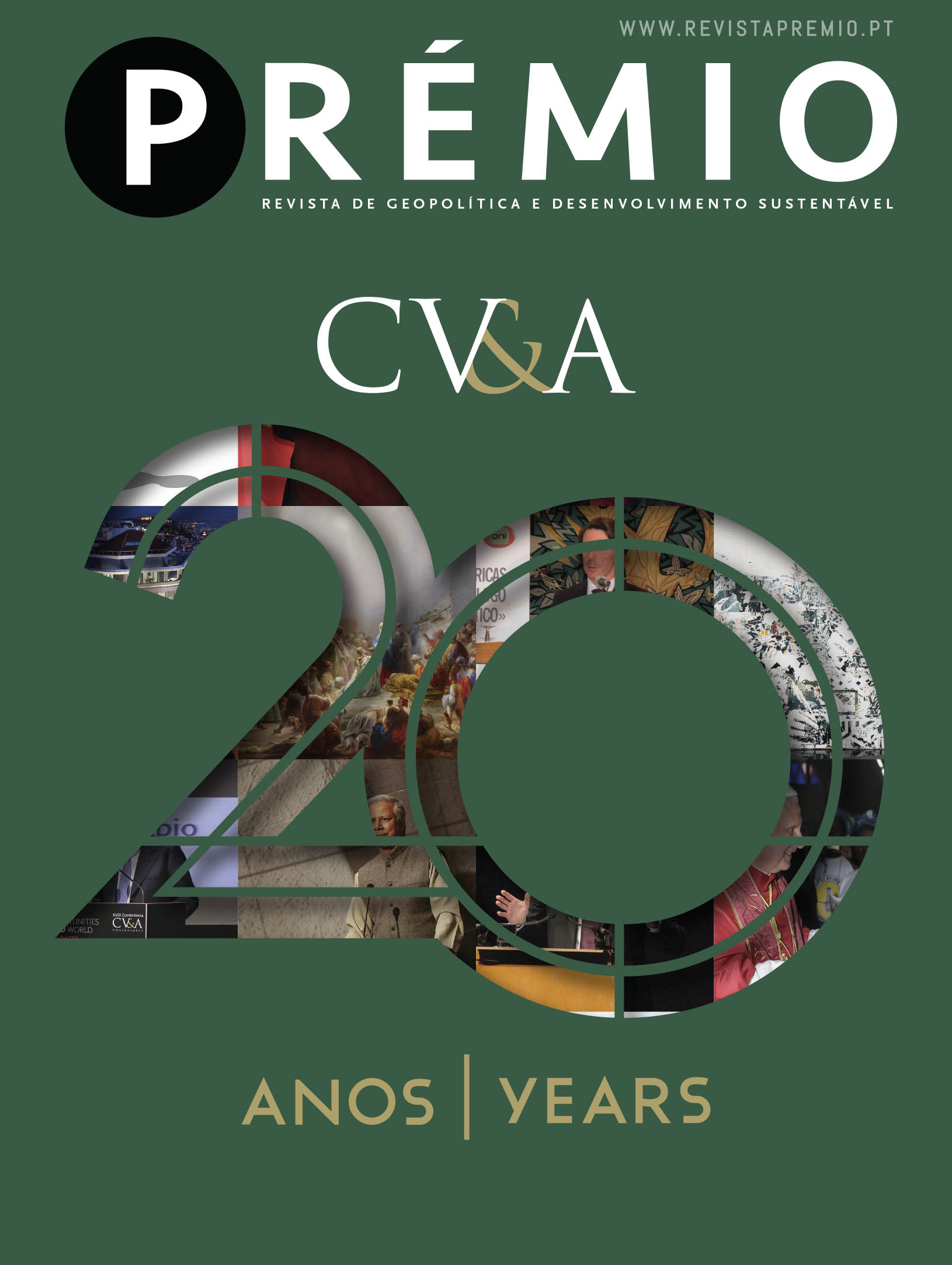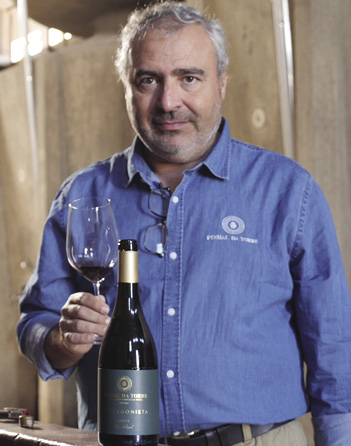João Barbosa
International markets account for around 90% of Pinhal da Torre wine sales. The properties hosting the vines are located in Alpiarça, in the Tejo wine growing region. In the past, the firm strove to produce the maximum quantity. However, the objective for the last three decades has been rather different.
It was less an act of madness but rather of daring. Launching aged wines in a market that prefers more recent vintages does run risks. The Pinhal da Torre company in Alpiarça did just that. This was an aware and considered option, explained wine-maker Paulo Saturnino Cunha.
Paulo Saturnino Cunha clarified how it is not common for consumers to store wines at home. Hence, the company takes on this task and assuming risks that few other Portuguese companies are willing to run. Perhaps only in the case of the fortified wines – such as Madeira and Port – are they sold to retail various years after the year of harvest, he added.
The producer went on to put the average level of Pinhal da Torre grape production at 220 tons – a quantity enough for around 150,000 litres of wine, in turn, filling close to 200,000 bottles. However, the wines in the lower quality range are placed for sale just a few years after harvest: representing around 60% of the total.
The prices (recommended retail price) start out at six euros and already significantly higher than the vast majority of wines sold in Portugal (80% are below three euros). The basic range debuts after three or four years while the ‘super premium’ and ‘luxury’ take between five and eight years of maturing.
“It is just not possible to make every wine absolutely fantastic. We attempt to make a mix with the entrance level wines generating enough resources and cashflow to keep the company running. However, the major gains are made from making unique wines, highly differentiated and with their own personalities”. Other company activities may also help in establishing the resources to invest in top of the range production.
One important factor, stated Paulo Saturnino Cunha, is the agricultural program of practice that not only begins everything but is also determinant to the final result. “We have a program for happy grapes – the Happy Grapes Program, which is patented. When we have happy grapes, we have great prospects for producing happy wines. We end up happy and we make sure that our consumers get the same happiness”.


Pinhal da Torre owns 43 hectares of vineyards spread over four different properties
Storing and waiting
The world has changed, life accelerating with it and it is not common today to buy wine and wait for that moment when it is best for drinking. Purchases are made to be drunk shortly thereafter and in some cases this practically amounts to ‘infanticide’, the producer highlighted.
Aware of this capacity for ageing, Paulo Saturnino Cunha takes on the costs of storage through to the right moment for its release to the public. He currently has over 120,000 bottles in stock.
The vintner opts not to pasteurise his wines as they “are a living being”. Thus, they evolve in the bottle in which each then, over the course of time, develops certain differentiating characteristics. “Pasteurisation kills everything”.
“It starts out as a child and then enters an adult phase. We have the tendency to sell our wines at an adult and mature age when they demonstrate all their potential and generate the greatest pleasures. Clearly, there are many consumers that do not value this, who like young wines that have different characteristics. What we like is to impress and surprise the oenophile”.
Another Pinhal da Torre characteristic is to store wines for their ow usage – the oldest vintage comes from 1990 and is not for sale. This depends on the range of wine, the year and the quantity of bottles there is in the cellar. For the future memory, this stands at between 500 and 1000, informed Paulo Saturnino Cunha. “This enables the evaluation of their longevity and the evolution in their characteristics – thus, this is an investment. Elsewhere, this is common but it is very rare in Portugal, especially due to pressure from those responsible for sales and the pressures on the treasury needs of these companies”.
Obviously, storing wines for various years before putting them on the market and storing bottles for their memory comes with costs. Should the business provide for them, that is only because the commercial strategy has returned good results.
A winery with almost 75 years of age
The company is to invest “various millions” in forthcoming years with the target date of 2023. The funding is going to improving the wine cellar, procuring new equipment and building wine tourism and agriculture facilities.
The winery will be improved but is to retain the seven cement cubes installed at the time of construction of this infrastructure. These facilities have their own advantages, especially good control over temperature.
The company owner referred to how wine tourism reflected a very important investment with the expectation of good results due to the location of Alpiarça: connected by the A1 motorway and other thoroughfares to the Algarve. The town is close to Fátima and 40 minutes from Lisbon and its airport– he explained.
Paulo Saturnino Cunha highlighted how, in accordance with the quality of the wines, the crushing of the grapes requires different approaches. This may be done by foot in stone tanks or by presses in stainless steel cubes.
Pinhal da Torre has its own set of barrels – in sum, with the capacity for around 30,000 litres – with different properties, especially in French oak from the Allier Forest. The maturing lengths are not the same for all wines. For example, a top of the range IPO, which has only been produced in two years (2008 and 2013), spends five years in wood, followed by another in a stainless steel cube and another two in the bottle before going out for sale.
Nevertheless, the portfolio is made up of 16 references, including reds and whites and some stand out specials. The latter group includes a late harvest but before the onset of that known as noble rot (the fungus botrytis cinerea), which provides the renown to the Sauternes (France) and Tokaji (Slovakia and Hungary). Under preparation is a fortified tipple (a common style in Portugal – fermentation halted through adding brandy) – although still without any date for putting on the shelves.


Pinhal da Torre owns 43 hectares of vineyards spread over four different properties
The designation of origin matters
Despite the positive change from Ribatejo to Tejo in 2009, this region has not yet in Portugal gained a reputation to achieve the highest levels of value. Portuguese consumers choose according to the designation of origin but the almost complete lack of awareness of Portugal internationally ends up avoiding this reticence about wines from the lands adjoining the capital.
Portugal is not internationally known as a producer of great prestige. The Madeira and Port fortified wines are the exceptions even if their consumers do not always identify them as the products of Portugal. Furthermore, the reluctance of Portuguese wine drinkers as regards denomination of origin do not reflect in the choices made abroad. “Bit by bit, wine critics have been giving value to Portugal. The problem is the price perception” – explained Paulo Saturnino Cunha.
Hence, Pinhal da Torre suffers from the prejudice towards Portugal in which the perception of value is low but gets around the national lack of trust. Paulo Saturnino Cunha added that the international consumer, the target of his business, is highly demanding. That termed the saudade market, the emigrant community yearning for a taste of home, is not appropriate for the Pinhal da Torre wines.
The family of Paulo Saturnino Cunha – the various branches that are behind him in terms of time – have been in the region for generations. On both his maternal and paternal sides, the genealogical roots reach back, in one of the cases to a great-grandfather of a great-grandfather. Certainly, he highlighted, he would have still more distant relatives: “Of my four great-grandparents only one was not from here”.
The family’s lands were once large, today covering 43 hectares although the rounding off makes them seem larger. In times past, strawberry production – one of the largest in the country – was the main activity.
From the historical business to different paradigms
Vines have long been cultivated on the properties making up the Pinhal da Torre estate. Formerly, large quantities were the target and sold in bulk. The vineyards stretched to 200 hectares, with Fernão Pires – an emblematic cast of this region – predominating.
In 1993, a reversal in the philosophy was decided on and opting for quality wines with a far lower level of productivity. They took out the vines from the lands of higher quantitative yields and placed others in less fertile soils but resulting in better grapes. Currently, 85% of the soils are sandy. New casts were introduced. Some disappointed for various reasons but the Touriga Nacional cast, for example, has flourished.
The harvesting of the whites begins in August. The red grapes are gathered between September and October. Leaving the grapes on the vine through to the tenth month brings risks, especially rain related due to rot or the reduction in the level of alcohol with higher water levels in the grapes.
Agriculture on Pinhal da Torre forms an integrated production system, preferably organic but not always in practice. “Not every year do we try organic. It depends on the characteristics prevailing. There are years in which if you do not intervene, you’ll not be picking a single grape. There are those who say that they do this but we are not liars”. Therefore, the working practices are not certified but, in parallel, some of the wines do get classed as vegan.
The company runs three estates and two plots of land. Quinta do Alqueve, with limestone soils, spans six hectares. With its sandy soils, Quinta de São João is also made up of a half-dozen hectares. Águas Vivas runs over 30 hectares of sandy soils and rocky outcrops. The remaining terrain features three hectares of alluvium.
The producer invests above all in national grapes casts, over 90%, a differentiating factor in international markets. “Nobody comes to Portugal to buy a Chardonnay”. Nevertheless, out of the preference of Paulo Saturnino Cunha and their good performance in the terroir (natural characteristics) ensure that some foreign cultivars are raised.
Quinta de Alqueve has planted Touriga Franca and Grenache. On Quinta de São João, there are Tinta Roriz (red) and Syrah (red). On Águas Vivas, there is Alicante Bouschet – red and so widely cultivated here, it is perhaps more Portuguese than any other country –, Alvarinho (white), Arinto (white), Baga (red), Fernão Pires (white), Fernão Pires Rosado (rose red), Merlot (red), Ramisco (red), Sousão (red), Syrah, Tinta Francisca (red), Tinta Roriz, Tinto Cão (red), Touriga Franca (red), Touriga Nacional (red), Verdelho (white) and Viosinho (white). In Courela Grande (plots), Alicante Bouschet is under cultivation.
Another 11 hectares are shortly due for plantation. The choice for these lands has gone to Alicante Bouschet, Arinto, Sousão, Touriga Franca and, “in principle, Tinta da Barca (red), which will be the only one to enter. On the way out is Tinta Roriz, whose results have not been uniform from year to year. You cannot have a cast that makes a sensational wine every ten years”.
The choice of grape type is obviously not down to the personal whims and preferences of Paulo Saturnino Cunha, such as the Merlot. Some casts are here for their characteristics that aid the longevity of the wines they produce, especially through their acidity. Arinto, Baga, Sousão and Ramisco – the great cast of Colares that produces living nectars after decades maturing – have great potential for storage.
Despite the careful selection of casts, one turned up without being invited. “The Grenache came by mistake. We had requested the vine grower for Tempranillo (Tinta Roriz) from Toro (Castile-León) for half a hectare. Only after some time did we realise that it was Grenache. We usually use it in blends but today provides some very interesting outcomes. In 2017, we decided, as a test, to make it pure. But we have already given it a greater highlight in 2013 in a blend with Syrah” – recounted Paulo Saturnino Cunha.
The winery work is also another option that few producers take on. All of the yeasts are indigenous to confer personality and differentiation the producer explained. “It is a risk when the quality of the grapes is not absolutely healthy. When the grapes are healthy, this is an expression, 100%, of the characteristics of the cast and the terroir. This has always worked. Sometimes, we use just a few selected yeasts but that never represent more than 5%”.
Another important investment comes with the replacement of the vines across 3.5 hectares. Usually, the vine comes from the grower already with rootstocks. Now, the grafting is to take place in the field in a task that few can do and is substantially expensive and implies a year without any fruit, identified the producer. However, “the results are deeper roots, pulling less on the plant, which has its own benefits “, and generating a higher level of final quality.
The teams is small, added Paulo Saturnino Cunha. The fundamental core is made up of Mário Andrade (oenologist) and Nuno de Jesus (winery manager). However, the winery is but one place of work. The vintner testified that the quality begins on the vine, the most important stage in the process.







